Keyspan USA-19H, USA-19HS Manual
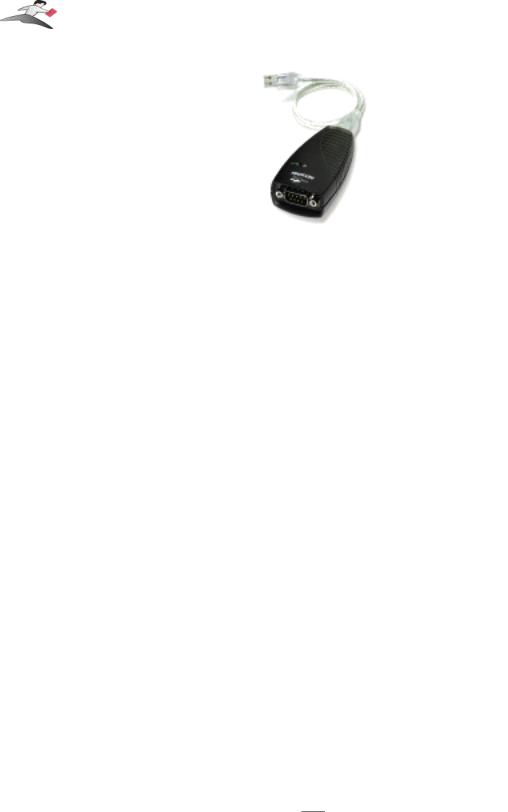
Keyspan:USB Serial Adapter for Windows-v3.4 Manual
Table of Contents
¥Introduction
¥Capabilities
¥Installation Instructions
¥Configuring Your Serial Device
¥Keyspan Serial Assistant
¥Problem Solving
¥Appendices
¥Frequently Asked Questions (FAQs)
¥Compatibility List for Windows
¥Configuration Examples for Windows
¥Serial Port Pin Outs
¥LED Behavior
¥TX Ack Advance
¥Notices
¥Keyspan Warranty Information
¥Support Information
This User Manual applies to the Keyspan USB Serial Adapter Software for Windows.
Rev 03jul13 |
Page 1 |

Keyspan:USB Serial Adapter for Windows-v3.4 Manual
1.1 - Introduction
Looking for a way to connect your serial devices to a USB port on your USB equipped Windows computer? The Keyspan USB Serial Adapter is a simple, inexpensive, and reliable way to make this connection.
The Adapter plugs into any USB port on your PC. It provides one DB9 serial port which can be used to connect to your Palm Organizer, WindowsCE device, Wacom tablet, and many other serial devices.
Multiple Keyspan USB Serial Adapters may be installed on one CPU if desired.
Requirements
The Keyspan USB Serial Adapter Software for Windows requires the following:
¥Windows:
¥At least one available USB port
¥Windows 98 / 98 SE / 98 Me / 2000 / XP
Contents
The Keyspan USB Serial Adapter package includes:
¥Keyspan USB Serial Adapter (USA-19H)
¥USB cable
¥Mac and Windows compatible CD with software and user manual
Note: This documentation applies to Keyspan's USB Serial Adapter Software for Windows and covers the features and use of this software on that platform. For information and instructions for this product on other platforms, please visit Keyspan's web page <http://www.keyspan.com>.
This User Manual applies to the Keyspan USB Serial Adapter Software for Windows.
Rev 03jul13 |
Page 2 |

Keyspan:USB Serial Adapter for Windows-v3.4 Manual
2.1 - Capabilities
The Keyspan USB Serial Adapter provides one male DB9 serial port which supports RS-232 asynchronous communications at data rates up to 230 Kbps. Please read our
Compatibility List for Windows for a list of serial devices that have been tested with the Keyspan USB Serial Adapter.
Keyspan USB Serial Adapter Port
Keyspan USB Serial Adapter
Serial Port
The DB9 port on the Keyspan Adapter is seen as a COM port by Windows. The Keyspan COM port is interfaced via the "Win32 Communications API" and is then available to any program that accesses COM ports via this API.
By default, the COM port number assigned to the Keyspan adapter is the first unassigned (available) COM port number in the Windows registry. For example, if COM1 and COM2 have already been assigned or set aside by any software or hardware, the Keyspan adapter will take the next COM port (COM3). This COM port number can then be accessed via your serial device's software (ie Palm's HotSync Manager, Wacom tablet control panel, etc.)
Note: You can connect more than one Keyspan USB Serial Adapter to your USB equipped Windows computer. The DB9 ports on subsequent adapters will have a different COM port numbers.
This User Manual applies to the Keyspan USB Serial Adapter Software for Windows.
Rev 03jul13 |
Page 3 |

Keyspan:USB Serial Adapter for Windows-v3.4 Manual
3.1 - Installation Instructions
Installing the USB Serial Adapter Software for Windows Operating Systems
Note: These instructions apply to installing the Keyspan USB Serial Adapter on Windows. If you are installing this software on other platforms, please read the Keyspan USB Serial Software User Manual for that platform.
Step 1 - Insert the Keyspan Serial Adapter CD-ROM
Turn your computer ON. When your computer starts up, place the Keyspan USB Serial Adapter CD into the CD-ROM drive.
This will open the Keyspan USB Serial Adapter CD browser browser by locating and running the "Launch.exe" program
(Note: you can manually start the CD on the CD-ROM).
Step 2 - Run the Keyspan USB Serial Software for Windows Installer
If the Keyspan Adapter is connected to your computer, disconnect it now.
Once the Keyspan CD browser has opened, click on the "Install Software" selection and then click on the "Install Keyspan USA19H Software" selection. This will start the software installer.
Follow the instructions on-screen to complete the installation.
Step 3 - Software Installation Complete!
Now that you have installed the Keyspan USB Serial Adapter software, you are ready to install the Keyspan USB Serial Adapter hardware. Please proceed to the installing the Keyspan USB Serial Adapter Hardware instructions.
(continued on next page...)
This User Manual applies to the Keyspan USB Serial Adapter Software for Windows.
Rev 03jul13 |
Page 4 |

Keyspan:USB Serial Adapter for Windows-v3.4 Manual
Installing the Keyspan USB Serial Adapter Hardware
The following hardware installation instructions provide a basic overview on installing the Keyspan USB Serial Adapter in a USB port. For detailed instructions on how to connect USB devices your specific computer, please refer to the USB Device Install section in your computer's user's manual.
Step 4 - Connect the USB cable to the Adapter (if necessary)
If your Keyspan adapter does not have an attached USB cable, attach the included USB cable into the Keyspan adapter's USB port.
Step 5 - Connect the Adapter to your USB port
Attach the Adapter to your computer by connecting the Adapter's USB cable into any built-in USB port on your computer or USB Hub. It is not necessary to turn off your computer when attaching the Adapter.
Step 6 - Hardware Installation Complete!
Your Keyspan USB Serial Adapter is ready for use now that you have installed hardware and software.
Please proceed to the Configuring Your Serial Device section in this manual for instructions on what to do next.
This User Manual applies to the Keyspan USB Serial Adapter Software for Windows.
Rev 03jul13 |
Page 5 |

Keyspan:USB Serial Adapter for Windows-v3.4 Manual
4.1 - Configuring Your Serial Device
Prior to using your serial device (modem,UPS, etc.) with the Keyspan USB Serial Adapter, you must:
1.connect your serial device (hardware) to the Keyspan port
2.configure your serial device's software to use the Keyspan port
The following instructions provide a general overview of this process however we do provide specific configuration instructions for certain serial devices. For a list of these examples, please read the Configuration Examples for Windows Appendix in this manual.
Connecting Your Serial Device (Hardware)
If your Keyspan adapter is not connected, please do so NOW.
Step 1 - Connect Your Serial Device To The Keyspan Adapter
Attach your serial device's (ie Palm cradle, GPS, cell phone) serial cable to the serial port on your Keyspan USB Serial Adapter.
Step 2 - Determine Which Keyspan Port Your Serial Device Is Connected To
If your have a Keyspan product that has more than one serial port, please note which Keyspan serial port your serial device is connected to (the serial port on the Keyspan product, not your USB ports on your computer or USB hub). This information will become useful as we start Configuring Your Serial Device's Software.
Configuring Your Serial Device's Software
The following configuration instructions provide a basic overview of how to configure your software to use your Keyspan serial port(s). For specific instructions on how to operate your serial device, please refer to your serial device's user's manual for detailed instructions...
(continued on next page...)
This User Manual applies to the Keyspan USB Serial Adapter Software for Windows.
Rev 03jul13 |
Page 6 |
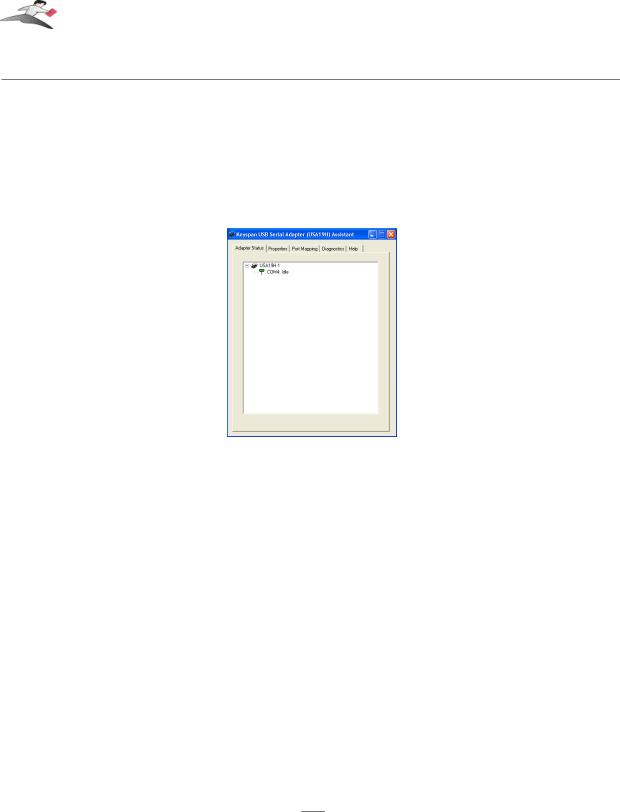
Keyspan:USB Serial Adapter for Windows-v3.4 Manual
Step 3 - Check the Keyspan Serial Assistant
Now that your serial device is connected to the Keyspan adapter, you should check to see if the Keyspan serial port is installed correctly.
To do this, open the Keyspan Serial Assistant (in Start menu -> Programs -> Keyspan USB
Serial Adapter -> Keyspan Serial Assistant). When you open the Keyspan Serial Assistant, you will see the following window:
the Keyspan Serial Assistant window
If your Keyspan hardware and software are installed correctly, you will see your adapter in the 'Adapter Status' tab box. You should also see the COM port number (ie COM1, COM2, etc.) and the COM Port Status.(IDLE or BUSY).
The COM port number and its COM port Status message are very important to configuring your serial device.
The COM port Status is the state of the Keyspan serial port. All serial ports have two states, BUSY (aka "In Use") or IDLE (aka "Available"). When serial port is IDLE, the port is available for use by any serial device's software. When a COM port is BUSY, the serial port is in use by software and therefore not available to other programs.
The COM port number is the address of the Keyspan serial port. In order for any serial device to communicate via the Keyspan adapter, that serial device's software must be told to use the Keyspan
COM port number.
If you see your COM port number and its COM port Status, proceed to Step 4. If you do not see either of these items, proceed Problem Solving section in this manual.
(continued on next page...)
This User Manual applies to the Keyspan USB Serial Adapter Software for Windows.
Rev 03jul13 |
Page 7 |

Keyspan:USB Serial Adapter for Windows-v3.4 Manual
Step 4 - Determine Where To Select/Configure The Keyspan Serial Port(s)
Prior to using your serial device with a Keyspan serial port, you must first tell that serial device's software which serial port your serial device hardware is connected to.
For example, if you have a Palm, you will have to tell the Palm Desktop software to look for your Palm handheld (hardware) on a Keyspan serial port. By doing this, you establish communication between your serial device's software (ie the Palm Desktop software) and your serial device hardware (the Palm handheld unit).
Most serial devices will have software that will allow you to select which serial port the device is connected to. Depending on your serial device and its software, you may have to configure: a Control Panel (ie modems accessing ISPs), an application (ie UPSes), or some combination of these (ie modems accessing terminals using Zterm).
Please refer to your serial devices documentation on which method your serial device uses and how to access that software's serial port "configuration" screen.
Once you've determined where to select or configure your serial device's software's serial port settings, please proceed to Step 5.
Step 5 - Determine Which Serial Port To Select In Your Serial Device's Software
When you've found the port selection screen in your serial device's software, you may be presented with a list of COM port numbers, a place to type in a COM port number, or some combination of both.
At this point, you have to select or enter COM port number of the Keyspan serial adapter you are connecting to. Please note that you can see the COM port number in the Adapter Status tab in the Keyspan Serial Assistant.
Step 6 - Use Your Serial Device
Once you've configured your serial software to use the Keyspan serial port, you're ready to start using your serial device under Windows.
This User Manual applies to the Keyspan USB Serial Adapter Software for Windows.
Rev 03jul13 |
Page 8 |
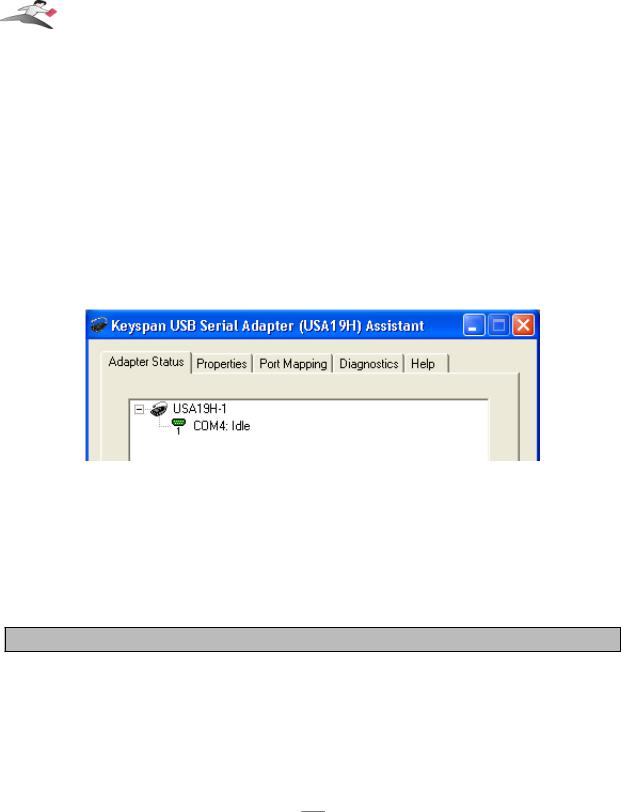
Keyspan:USB Serial Adapter for Windows-v3.4 Manual
5.1 - Keyspan Serial Assistant
Besides the required drivers, the Keyspan USB Serial Adapter software installer installs an application called Keyspan Serial Assistant. This application is used to:
¥Determine the status of the adapter software and hardware
¥Assist in problem solving
Launching the Keyspan Serial Assistant
To launch the Assistant, open the Keyspan Serial Assistant (in Start menu -> Programs ->
Keyspan USB Serial Adapter -> Keyspan Serial Assistant). When you open the Keyspan Serial Assistant, you will see the following window:
the Keyspan Serial Assistant window
If your Keyspan hardware and software are installed correctly, you will see your adapter in the 'Adapter Status' tab box. You should also see the COM port number (ie COM1, COM2, etc.) and the COM Port Status.(IDLE or BUSY).
If you see your COM port number and its COM port Status. If you do not see either of these items, proceed Problem Solving section in this manual.
Explanation of Assistant Features
The following is a description of all the relevant text boxes and menus found in the Keyspan Serial Assistant. You can also obtain this information by turning on the 'Enable Tool Tips' check box in the Help tab in the Assistant window.
(continued on next page...)
This User Manual applies to the Keyspan USB Serial Adapter Software for Windows.
Rev 03jul13 |
Page 9 |
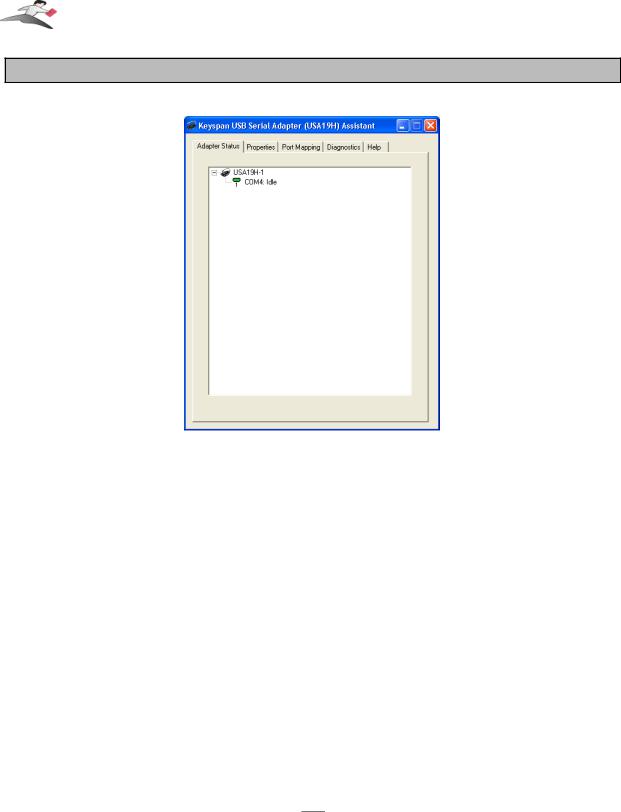
Keyspan:USB Serial Adapter for Windows-v3.4 Manual
Adapter Status Tab
the Adapter Status tab
The Adapter Status tab in the Keyspan Serial Assistant displays the status of your Keyspan adapter. Specifically, it shows the COM port number (ie COM1, COM2, etc.) and the COM Port Status.(IDLE or BUSY). If you have several Keyspan adapters of the same type, they will all show up in this tab.
This is also the first place to check to see if your Keyspan adapter is working properly. If your Keyspan adapter does not show up in the Adapter Status tab, please proceed Problem Solving section in this manual for further instructions.
(continued on next page...)
This User Manual applies to the Keyspan USB Serial Adapter Software for Windows.
Rev 03jul13 |
Page 10 |
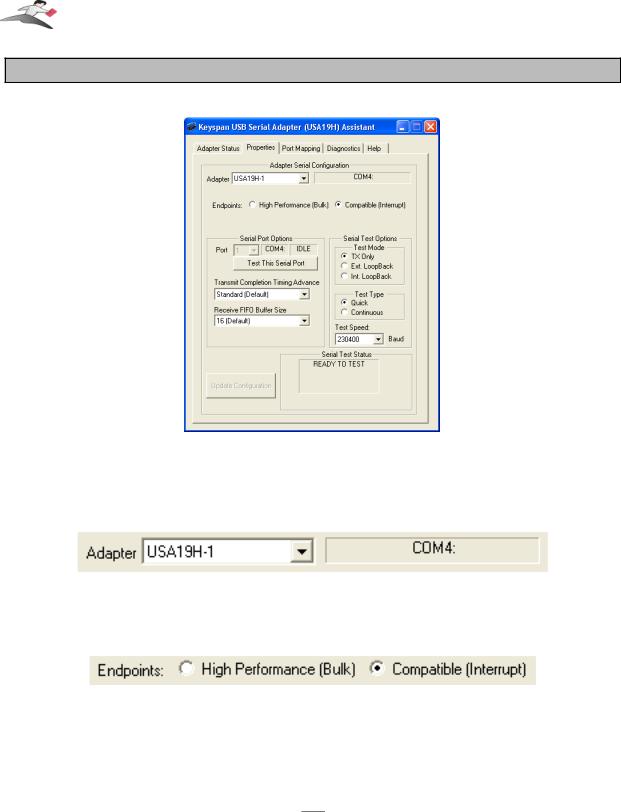
Keyspan:USB Serial Adapter for Windows-v3.4 Manual
Properties Tab
the Properties tab
The Properties tab in the Keyspan Serial Assistant allows you test your Keyspan adapter and make changes to the behavior of the Keyspan adapter. The following is an explanation of the items in this tab.
the Adapter pull down menu
The Adapter pull down menu is used to select which USB Serial Adapter you would like to configure. If you only have one Keyspan USB Serial Adapter, you will not need to change the selection.
the Endpoints radio buttons
The Endpoints radio buttons are used to configure how the Keyspan adapter will communicate with the USB subsystem (software)on your computer. Most users will not need to modify the default setting (Compatible (Interrupt)). You should only change this setting if you are sure that your serial device needs a specific setting. The default setting is Compatible (Interrupt).
This User Manual applies to the Keyspan USB Serial Adapter Software for Windows.
Rev 03jul13 |
Page 11 |
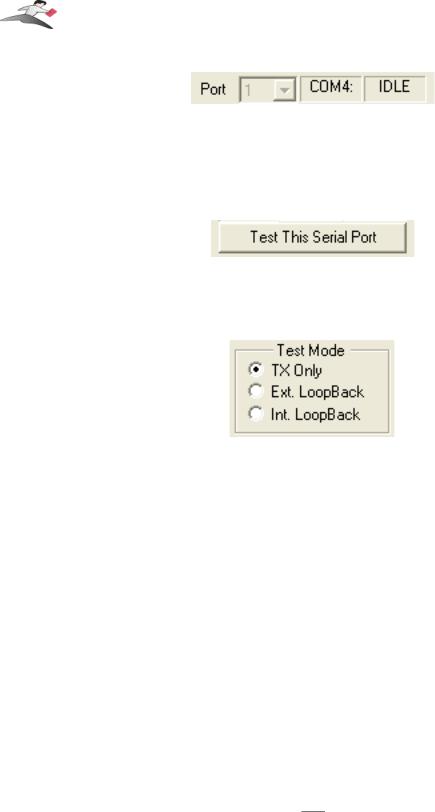
Keyspan:USB Serial Adapter for Windows-v3.4 Manual
the Port pull down
If you have more than one serial port on your Keyspan adapter, the Port pull down menu allows you select which serial port you want to modify or test. You can also see the serial port's COM port number and its COM port status next to the Port pull down menu. If you only have one serial port on your Keyspan USB Serial Adapter, you will not need to change the selection.
The Test This Port button
The Test This Port button tests the COM port selected in the Port pull down menu. The test that is performed is the selected test in the Test Option box.
the Test Mode box
The Test Mode box allows to specify the type of test that will be performed when you press the
Test This Port button.
There are 3 types of tests:
TX Only: Use this test to test only the transmit (Tx) signals of the Keyspan adapter.
Ext. LoopBack: Use this test sending and receiving data. This test sends data out the selected serial port and waits to receive it via a special Loopback connector. You can find more information about this special Loopback connector in the Serial Port Pin Outs section in this manual.
Int. Loop Back: Use this test sending and receiving data. This test is performed within the Keyspan adapter hardware. This test DOES NOT require a special Loopback cable.
(continued on next page...)
This User Manual applies to the Keyspan USB Serial Adapter Software for Windows.
Rev 03jul13 |
Page 12 |
